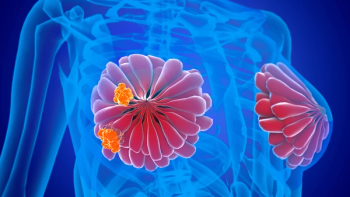
Osimertinib/Chemo Boosts OS in EGFR+ NSCLC With Poor Prognosis
Adding platinum-based chemotherapy to osimertinib improved overall survival vs osimertinib alone in EGFR-mutated NSCLC, even in high-risk subgroups.
The combination of osimertinib (Tagrisso) plus platinum-based chemotherapy and pemetrexed improved overall survival (OS) compared with osimertinib alone across subgroups of patients with EGFR-mutated advanced non–small cell lung cancer (NSCLC), including those with poor prognostic factors, according to findings from an exploratory analysis of the phase 3 FLAURA2 trial (NCT04035486).1
The exploratory analysis, which was presented at the
- Central nervous system (CNS) metastases (yes vs no)
- Bone metastases (yes vs no)
- Liver metastases (yes vs no)
- EGFR mutation status (exon 21 L858R mutation vs exon 19 deletion)
- TP53 status (altered vs wild-type)
- Plasma EGFR mutations in circulating tumor DNA (ctDNA; detected vs undetected)
“Hazard ratios for OS favored the combination arm, regardless of baseline prognostic factors, and were consistent with the overall population,” lead study author Pasi A. Jänne, MD, PhD, said in a presentation of the data. Jänne is a senior physician, senior vice president for Translational Medicine, director of the Belfer Center for Applied Cancer Science, director of the Chen-Huang Center for EGFR Mutant Lung Cancers, and the David M. Livingston, MD, Chair at Dana-Farber Cancer Institute, as well as a professor of medicine at Harvard Medical School in Boston, Massachusetts.
What Were the FLAURA2 OS Outcomes by Prognostic Subgroup?
In patients harboring CNS metastases at baseline, the median OS was 40.9 months (95% CI, 35.2-46.6) for osimertinib plus chemotherapy (n = 116) compared with 29.7 months (95% CI, 25.6-35.8) for osimertinib monotherapy (n = 110; HR, 0.72; 95% CI, 0.52-0.99). The 3-year OS rates in this subgroup were 57% (95% CI, 48%-66%) and 40% (95% CI, 31%-49%), respectively. In patients without CNS metastases at baseline, the median OS was not reached (NR; 95% CI, 45.0-NC) for osimertinib plus chemotherapy (n = 163) vs 43.9 months (95% CI, 37.8-53.3) for osimertinib alone (n = 168; HR, 0.77; 95% CI, 0.57-1.05).
Patients harboring EGFR exon 21 L858R mutations treated with osimertinib plus chemotherapy (n = 106) achieved a median OS of 38.1 months (95% CI, 33.4-42.0) vs 32.4 months (95% CI, 28.0-37.6) for osimertinib alone (n = 107; HR, 0.76; 95% CI, 0.55-1.07). The respective 3-year OS rates were 54% (95% CI, 44%-63%) and 42% (95% CI, 32%-51%). In patients harboring EGFR exon 19 deletions, the median OS was NR (95% CI, 47.2-NC) for osimertinib plus chemotherapy (n = 172) vs 43.0 months (95% CI, 35.7-51.9) for osimertinib alone (n = 169; HR, 0.76; 95% CI, 0.56-1.02).
Among patients with EGFR mutations detected in plasma ctDNA, the median OS was 38.4 months (95% CI, 33.2-46.6) for osimertinib plus chemotherapy (n = 148) vs 32.5 months (95% CI, 28.8-35.8) for osimertinib monotherapy (n = 161; HR, 0.79; 95% CI, 0.60-1.03). The 3-year OS rates in this subgroup were 53% (95% CI, 45%-61%) for osimertinib plus chemotherapy vs 42% (95% CI, 35%-50%) for osimertinib alone. In patients without EGFR mutations detected in plasma ctDNA, the median OS was NR (95% CI, 50.8-NC) and NR (95% CI, 46.0-NC) for the combination (n = 65) and osimertinib monotherapy (n = 48), respectively (HR, 0.79; 95% CI, 0.44-1.44).
In the subgroup of patients with liver metastases at baseline, osimertinib plus chemotherapy (n = 43) generated a median OS of 36.6 months (95% CI, 24.4-NC) compared with 28.0 months (95% CI, 21.3-32.5) for osimertinib alone (n = 66; HR, 0.66; 95% CI, 0.41-1.05). The 3-year OS rates were 54% (95% CI, 38%-68%) and 35% (95% CI, 24%-47%), respectively. In patients without liver metastases at baseline, the median OS was 49.6 months (95% CI, 43.0-NC) for osimertinib plus chemotherapy (n = 236) vs 41.8 months (95% CI, 35.7-49.8) for osimertinib alone (n = 212; HR, 0.83; 95% CI, 0.64-1.07).
For patients with bone metastases, the median OS was 40.2 months (95% CI, 33.9-47.2) for osimertinib plus chemotherapy (n = 132) vs 32.3 months (95% CI, 26.7-36.5) for osimertinib monotherapy (n = 142; HR, 0.76; 95% CI, 0.56-1.02). The 3-year OS rates were 55% (95% CI, 46%-63%) and 42% (95% CI, 34%-50%), respectively. In patients without bone metastases, the median OS was NR (95% CI, 46.6-NC) and 44.5 months (95% CI, 38.3-NC) for osimertinib plus chemotherapy (n = 147) and osimertinib alone (n = 136), respectively (HR, 0.79; 95% CI, 0.57-1.10).
Finally, in patients harboring TP53 alterations, those given osimertinib plus chemotherapy (n = 46) experienced a median OS of 51.1 months (95% CI, 35.0-NC) vs 43.1 months (95% CI, 34.0-50.1) for those administered osimertinib alone (n = 40; HR, 0.71; 95% CI, 0.40-1.27). The 3-year OS rates were 65% (95% CI, 49%-77%) and 58% (95% CI, 41%-71%), respectively. In patients with TP53 wild-type disease, the median OS was NR (95% CI, 46.6-NC) for osimertinib plus chemotherapy (n = 33) and NR (95% CI, 41.3-NC) for osimertinib alone (n = 34; HR, 0.70; 0.32-1.54).
How Was the FLAURA2 Trial Designed?
Notably, prior data from this study supported the February 2024
FLAURA2 enrolled patients at least 18 years of age with previously untreated, pathologically confirmed locally advanced or metastatic nonsquamous NSCLC harboring EGFR exon 19 deletions or exon 21 L858R mutations.1 Patients were also required to have a World Health Organization performance status of 0 or 1. Patients with stable CNS metastases were allowed to enroll, and brain scans were mandatory at baseline.
Patients were randomly assigned 1:1 to receive osimertinib at 80 mg per day in combination with pemetrexed at 500 mg/m2 and carboplatin at area under the curve 5 or cisplatin at 75 mg/m2 once every 3 weeks for 4 cycles, followed by osimertinib at 80 mg once per day plus pemetrexed at 500 mg/m2 once every 3 weeks as maintenance therapy; or osimertinib alone at 80 mg per day. Treatment beyond disease progression was permitted at investigator discretion.
Investigator-assessed progression-free survival per RECIST 1.1 criteria served as the trial’s primary end point. OS was a key secondary end point.
References
- Jänne PA, Planchard D, Kobayashi K, et al. FLAURA2: exploratory overall survival analyses in patients with poorer prognostic factors treated with osimertinib ± platinum-pemetrexed as first-line treatment for EGFR-mutated advanced NSCLC. Presented at: 2025 ESMO Congress; October 17-21, 2025; Berlin, Germany. Abstract LBA77.
- Tagrisso plus chemotherapy demonstrated a median overall survival of nearly four years, the longest benefit ever reported in a global Phase III trial in EGFR-mutated advanced lung cancer. News release. AstraZeneca. September 7, 2025. Accessed October 17, 2025. https://www.astrazeneca.com/media-centre/press-releases/2025/tagrisso-plus-chemotherapy-demonstrated-a-median-overall-survival-of-nearly-four-years.html
- FDA approves osimertinib with chemotherapy with chemotherapy for EGFR-mutated non-small cell lung cancer. FDA. February 16, 2024. Accessed October 17, 2025. https://www.fda.gov/drugs/resources-information-approved-drugs/fda-approves-osimertinib-chemotherapy-egfr-mutated-non-small-cell-lung-cancer
Newsletter
Knowledge is power. Don’t miss the most recent breakthroughs in cancer care.
















































































